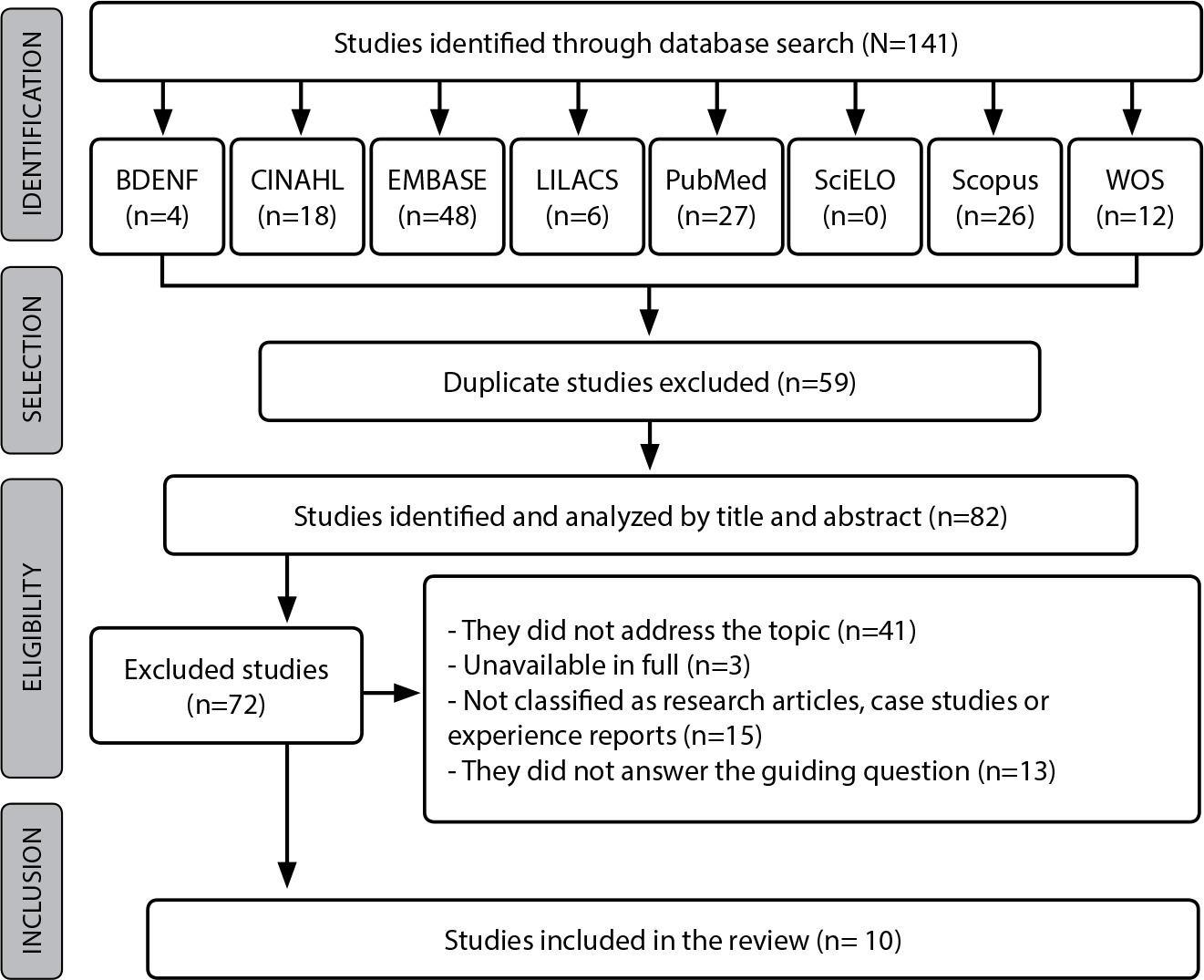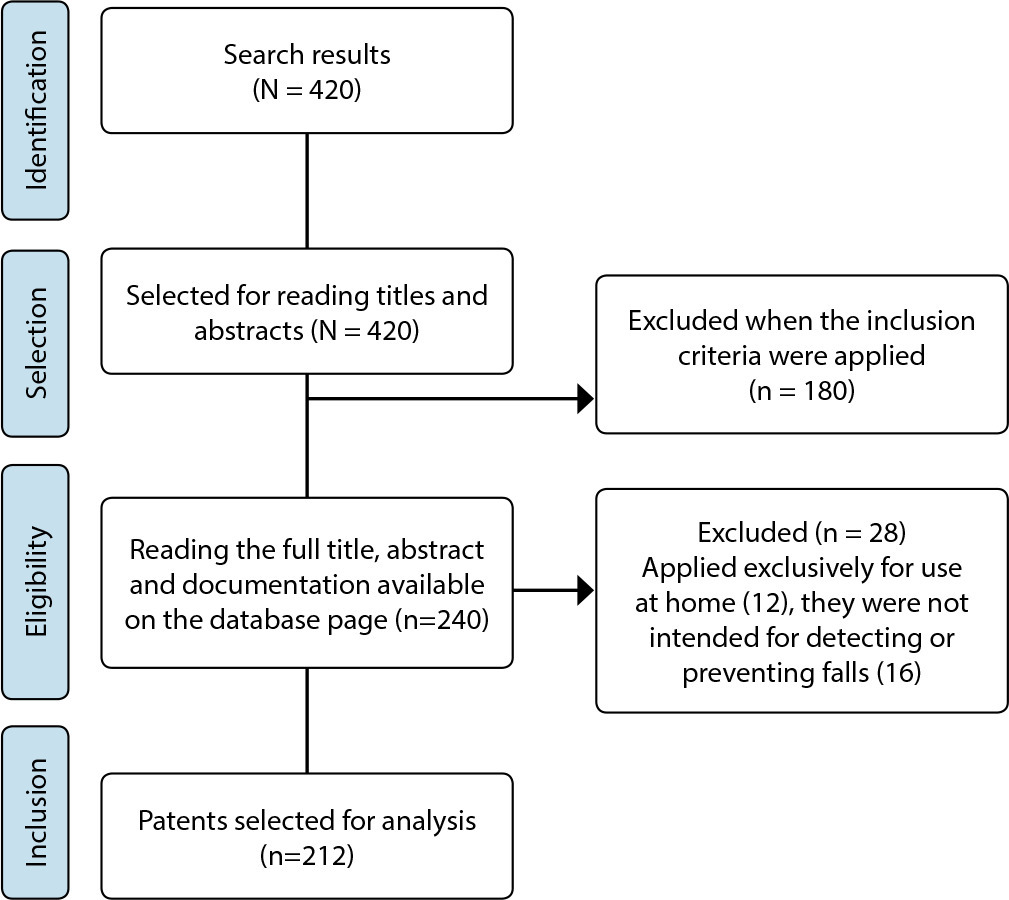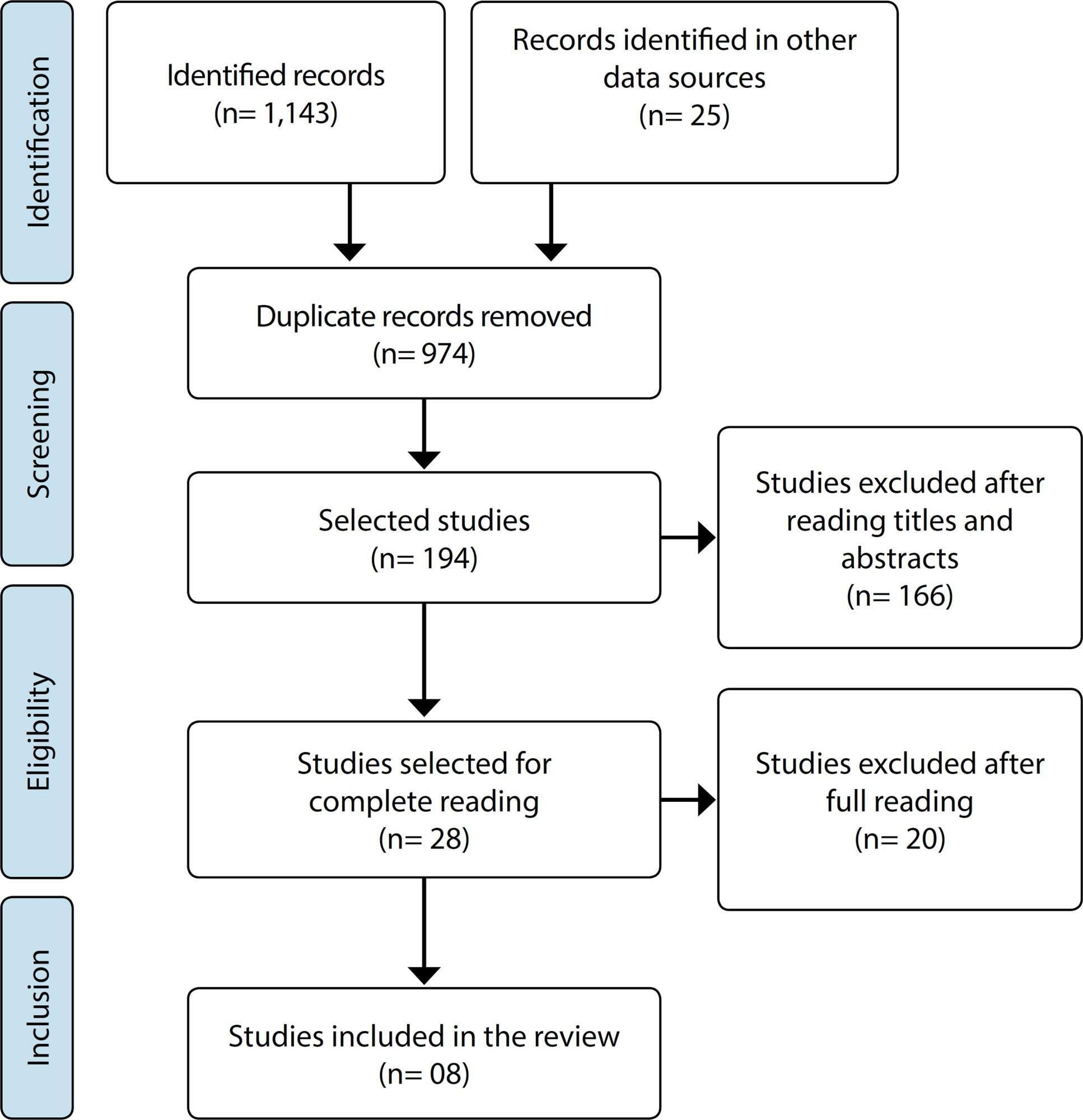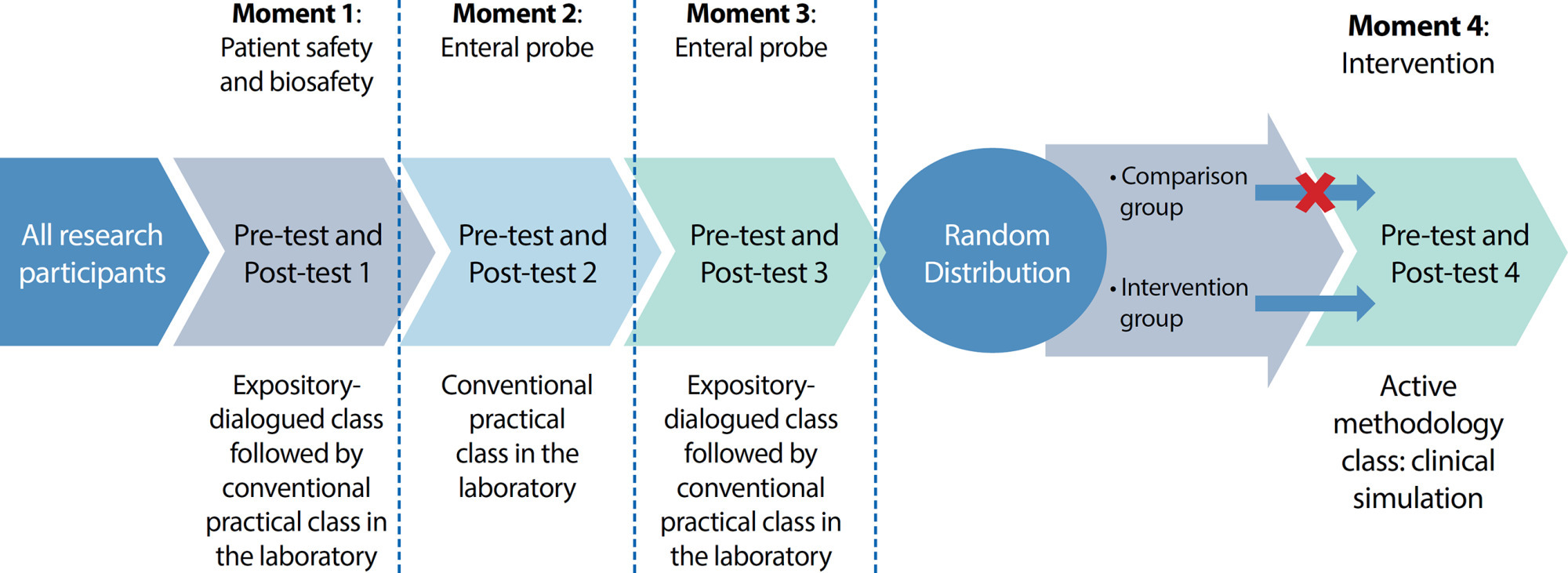-
26/02/2024
Enfermera Navegadora del Paciente Oncológico: aportes a la discusión en el escenario nacional
Revista Brasileira de Enfermagem. 2024;77(2):e770201
Resumen
Enfermera Navegadora del Paciente Oncológico: aportes a la discusión en el escenario nacional
Revista Brasileira de Enfermagem. 2024;77(2):e770201
DOI 10.1590/0034-7167.2024770201es
Visualizações1La práctica profesional de la navegación de pacientes es incipiente en Brasil y, por tanto, es fundamental una discusión amplia con diversos sectores de la sociedad, que es el objetivo principal de este editorial. Empecemos con la historia. La navegación de pacientes se definió en 1989 como una intervención de prestación de servicios basada en […]Ver mais -
ARTÍCULO DE REVISIÓN26/02/2024
Evidence of intrauterine device insertion by nurses in Primary Health Care: an integrative review
Revista Brasileira de Enfermagem. 2024;77(1):e20230134
Resumen
ARTÍCULO DE REVISIÓNEvidence of intrauterine device insertion by nurses in Primary Health Care: an integrative review
Revista Brasileira de Enfermagem. 2024;77(1):e20230134
DOI 10.1590/0034-7167-2023-0134
Visualizações0Ver maisABSTRACT
Objectives:
to synthesize and analyze evidence on intrauterine device insertion by nurses in Primary Health Care.
Methods:
an integrative review, carried out in the BDENF, CINAHL, LILACS, SciELO, Scopus, PubMed and Web of Science databases in June 2022, delimiting the period from 1960 to 2022.
Results:
141 articles were identified in the initial search, and 10 studies made up the final sample. Four (40%) were developed in the United States and one (10%) in Brazil, with publications from 1979 to 2021. The findings were grouped into three categories: Nurse training to insert an intrauterine device; Nurses’ competency to insert an intrauterine device; and Women’s access to intrauterine devices.
Conclusions:
nurse theoretical and practical training is a prominent element, consolidated in the favorable outcomes of insertions performed by nurses and satisfaction among women, a practice that has expanded access to the contraceptive method in Primary Health Care.

-
ARTÍCULO ORIGINAL26/02/2024
Artificial intelligence to predict bed bath time in Intensive Care Units
Revista Brasileira de Enfermagem. 2024;77(1):e20230201
Resumen
ARTÍCULO ORIGINALArtificial intelligence to predict bed bath time in Intensive Care Units
Revista Brasileira de Enfermagem. 2024;77(1):e20230201
DOI 10.1590/0034-7167-2023-0201
Visualizações0Ver maisABSTRACT
Objectives:
to assess the predictive performance of different artificial intelligence algorithms to estimate bed bath execution time in critically ill patients.
Methods:
a methodological study, which used artificial intelligence algorithms to predict bed bath time in critically ill patients. The results of multiple regression models, multilayer perceptron neural networks and radial basis function, decision tree and random forest were analyzed.
Results:
among the models assessed, the neural network model with a radial basis function, containing 13 neurons in the hidden layer, presented the best predictive performance to estimate the bed bath execution time. In data validation, the squared correlation between the predicted values and the original values was 62.3%.
Conclusions:
the neural network model with radial basis function showed better predictive performance to estimate bed bath execution time in critically ill patients.
-
ARTÍCULO ORIGINAL26/02/2024
Technological prospecting of patents related to monitoring accidents due to falls in hospitals
Revista Brasileira de Enfermagem. 2024;77(1):e20230084
Resumen
ARTÍCULO ORIGINALTechnological prospecting of patents related to monitoring accidents due to falls in hospitals
Revista Brasileira de Enfermagem. 2024;77(1):e20230084
DOI 10.1590/0034-7167-2023-0084
Visualizações0Ver maisABSTRACT
Objectives:
to map the production of technologies aimed at monitoring falls in a hospital environment protected by registered patents.
Methods:
a technological prospecting of international patents, with a quantitative approach, with search carried out between February and March 2022 in the Derwent Innovations Index database with descriptors fall, hospital, monitoring.
Results:
212 patents were found, with the majority filed and published since 2010, by Tran B (9) and Cerner Innovation Inc (9), focused on health technology. Universities were responsible for 13% of deposits. There was a predominance of records from the United States (43.4%), China (21.7%) and Japan (12.3%), in addition to technological strategies classified as devices for the environment (80.7%) and for preventing falls (66.5%) as well as trend towards resources with multiple functionalities in the same technology.
Conclusions:
the plurality of functions in the same device reflects the search for optimizing resources and the concern with comprehensive care.

-
ERRATUM26/02/2024
ERRATUM
Revista Brasileira de Enfermagem. 2024;77(1):e20230045
Resumen
ERRATUMERRATUM
Revista Brasileira de Enfermagem. 2024;77(1):e20230045
DOI 10.1590/0034-7167.20247701e04
Visualizações2In the article “Coping strategies for chronically ill children and adolescents facing the COVID-19 pandemic”, with DOI number: , published in Revista Brasileira de Enfermagem, 2023;76(Suppl 2):e20230045, in the author:Where it read:[…]Ver mais -
ERRATUM26/02/2024
ERRATUM
Revista Brasileira de Enfermagem. 2024;77(1):e2024n1e02
Resumen
ERRATUMERRATUM
Revista Brasileira de Enfermagem. 2024;77(1):e2024n1e02
DOI 10.1590/0034-7167.20247701e02
Visualizações2In the article “Active teaching model to promote critical thinking”, with DOI number: , published in Revista Brasileira de Enfermagem, 2019;72(1):293-8, on page 297:Include before REFERENCES:[…]Ver mais -
ERRATUM26/02/2024
ERRATUM
Revista Brasileira de Enfermagem. 2024;77(1):e20160061
Resumen
ERRATUMERRATUM
Revista Brasileira de Enfermagem. 2024;77(1):e20160061
DOI 10.1590/0034-7167.20247701e03
Visualizações2In the article “Nurses in the labor market: professional insertion, competencies and skills”, with DOI number: , published in Revista Brasileira de Enfermagem, 2017;70(6):1220-6, on page 1225:Include before REFERENCES:[…]Ver mais -
ARTÍCULO DE REVISIÓN26/02/2024
Practice of immersion in hot water to relieve pain in neonatology: an integrative review
Revista Brasileira de Enfermagem. 2024;77(1):e20230260
Resumen
ARTÍCULO DE REVISIÓNPractice of immersion in hot water to relieve pain in neonatology: an integrative review
Revista Brasileira de Enfermagem. 2024;77(1):e20230260
DOI 10.1590/0034-7167-2023-0260
Visualizações1Ver maisABSTRACT
Objectives:
to identify immersion use in hot water to relieve pain in newborns.
Methods:
an integrative literature review, carried out in the PubMed, VHL, EMBASE, Scopus, CINAHL, Cochrane and SciELO databases, with investigations in English, Spanish, French or Portuguese, published between 2002 and 2022. The Health Sciences Descriptors (DeCS) and Medical Subject Headings (MeSH) were used to answer the following question: what are the uses of hot water immersion in relieving pain in newborns?
Results:
nine studies were included, mainly Brazilian, experimental, with a predominance of strong and moderate levels of evidence. Hydrotherapy and bath use (immersion and bandaging) was observed, promising interventions in reducing pain scores, assessed using scales, physiological and endocrine parameters.
Conclusions:
hot water proved to be a promising non-pharmacological intervention in relieving pain in infants in different contexts.

-
ARTÍCULO ORIGINAL19/08/2019
Interrupções e carga de trabalho de enfermagem durante a administração de medicamentos
Revista Brasileira de Enfermagem. 2019;72(4):1001-1006
Resumen
ARTÍCULO ORIGINALInterrupções e carga de trabalho de enfermagem durante a administração de medicamentos
Revista Brasileira de Enfermagem. 2019;72(4):1001-1006
DOI 10.1590/0034-7167-2018-0680
Visualizações0RESUMO
Objetivo:
Investigar fontes e causas das interrupções durante o processo de administração de medicamentos realizado pela equipe de enfermagem e mensurar sua frequência, duração e impacto sobre a carga de trabalho.
Métodos:
Observacional com tempos cronometrados durante 121 rodadas de medicação (preparo, administração e documentação) realizadas por 15 enfermeiros e nove técnicos de enfermagem em Unidade de Terapia Intensiva Neonatal no interior de São Paulo.
Resultados:
Foram observadas 63 (52,1%) interrupções. Em cada rodada, ocorreram de 1-7totalizando 127, principalmente na fase de preparo, 97 (76,4%). As principais fontes constituíram-se em: equipe de enfermagem − 48 (37,8%) − e autointerrupções − 29(22,8%). Já as principais causas: troca de informações – 54 (42,5%) − e conversa paralela – 28 (22%). O aumento do tempo médio variou de 53,7 a 64,3% (preparo) e de 18,3 a 19,2% (administração) p≤0,05.
Conclusão:
Interrupções no processo medicamentoso são frequentes, interferem na carga de trabalho da enfermagem e podem refletir na segurança do cuidado.
Palavras-chave: Carga de TrabalhoCuidados de EnfermagemFluxo de TrabalhoGerenciamento do TempoSegurança do PacienteVer mais -
ARTÍCULO ORIGINAL07/03/2022
Pacientes críticos com COVID-19: perfil sociodemográfico, clínico e associações entre variáveis e carga de trabalho
Revista Brasileira de Enfermagem. 2022;75:e20210119
Resumen
ARTÍCULO ORIGINALPacientes críticos com COVID-19: perfil sociodemográfico, clínico e associações entre variáveis e carga de trabalho
Revista Brasileira de Enfermagem. 2022;75:e20210119
DOI 10.1590/0034-7167-2021-0119
Visualizações0RESUMO
Objetivo:
Identificar o perfil sociodemográfico e clínico de pacientes com COVID-19; mensurar carga de trabalho e realizar associações entre variáveis clínicas.
Métodos:
Estudo transversal, 150 pacientes adultos com COVID-19 em unidade de terapia intensiva (marçojunho/2020). Dados do prontuário eletrônico nas primeiras 24 horas de internação: sexo, idade, escolaridade, procedência, comorbidades, ventilação mecânica invasiva, manobra prona, terapia renal substitutiva, lesão por pressão, Braden, Nurging Activies Score, diagnósticos e cuidados de enfermagem. Análise estatística descritiva, associações entre variáveis clínicas e grupo etário.
Resultados:
Sexo masculino (55,3%); idade média, 59 anos; hipertensos (57,3%); obesos (50,6%); diabéticos (34%); ventilação mecânica invasiva (66,7%); pronados (20,6%); hemodiálise (15,3%); média do Nursing Activities Score, 86%. Encontraram-se 28 diagnósticos de enfermagem e 73 cuidados.
Conclusão:
Pacientes necessitaram de suporte de alta complexidade. Houve associação significante entre lesão por pressão e carga de trabalho com manobra prona. Os diagnósticos e cuidados de enfermagem refletem necessidades dos pacientes críticos.
Palavras-chave: Carga de TrabalhoDiagnóstico de EnfermagemInfecções por CoronavirusProcesso de EnfermagemUnidades de Terapia IntensivaVer mais -
ARTÍCULO DE REVISIÓN11/06/2021
Mental health interventions implemented in the COVID-19 pandemic: what is the evidence?
Revista Brasileira de Enfermagem. 2021;74:e20200635
Resumen
ARTÍCULO DE REVISIÓNMental health interventions implemented in the COVID-19 pandemic: what is the evidence?
Revista Brasileira de Enfermagem. 2021;74:e20200635
DOI 10.1590/0034-7167-2020-0635
Visualizações0Ver maisABSTRACT
Objective:
to map the evidence on mental health interventions implemented during the COVID-19 pandemic.
Method:
this scoping review was carried out in the MEDLINE/PubMed, SCOPUS, Web of Science, PsycINFO, and Science Direct databases and in the medRxiv, bioRxiv, and PsyArXiv preprints servers using the descriptors “Covid-19”, “coronavirus infection”, “coronavirus”, “2019-nCoV”, “2019 novel coronavirus disease”, “SARS-CoV-2”, “health personnel”, “general public”, and “mental health”.
Results:
eight articles were selected and categorized into mental health interventions for the population, among which mental health interventions were for people diagnosed with suspicion/confirmed COVID-19 and mental health interventions for health professionals.
Conclusion:
telemonitoring, virtual games and strategies focused on social support and muscle relaxation techniques, characterized as non-pharmacological and low-cost, were shown as interventions, which, since they are effective, need to be encouraged and included in mental health care practices.

-
16/07/2021
Qualidade do sono e sua associação com os sintomas de menopausa e climatério
Revista Brasileira de Enfermagem. 2021;74:e20201150
Resumen
Qualidade do sono e sua associação com os sintomas de menopausa e climatério
Revista Brasileira de Enfermagem. 2021;74:e20201150
DOI 10.1590/0034-7167-2020-1150
Visualizações0Ver maisRESUMO
Objetivo:
Avaliar a qualidade do sono em mulheres menopausadas e sua associação com os sintomas relacionados a esse período.
Método:
Estudo transversal, analítico e correlacional. O sono foi avaliado por meio do Índice de Qualidade do Sono de Pittsburgh; e os sintomas do climatério, pelo Menopause Rating Scale. Para a comparação do escore total e de cada domínio do Menopause Rating Scale com a classificação do Índice de Qualidade do Sono de Pittsburgh (PSQI), foi utilizado o teste não paramétrico U de Mann-Whitney. Considerou-se valor p<0,05 como significante.
Resultados:
Foram classificadas 261 mulheres (67,8%) como más dormidoras. Houve correlação positiva e significativa dos escores da escala do sono com o escore total da menopausa e seus domínios. As mulheres categorizadas como más dormidoras apresentaram piores escores na escala de sintomas de menopausa.
Conclusão:
Mulheres com pior qualidade do sono revelaram maior severidade dos sintomas relacionados à menopausa.
-
ARTÍCULO ORIGINAL21/10/2019
“À espera de um milagre”: espiritualidade/religiosidade no enfrentamento da doença falciforme
Revista Brasileira de Enfermagem. 2019;72(6):1554-1561
Resumen
ARTÍCULO ORIGINAL“À espera de um milagre”: espiritualidade/religiosidade no enfrentamento da doença falciforme
Revista Brasileira de Enfermagem. 2019;72(6):1554-1561
DOI 10.1590/0034-7167-2018-0635
Visualizações1Ver maisRESUMO
Objetivo:
Compreender a Espiritualidade/Religiosidade vivenciadas por pessoas com doença falciforme e sua influência sobre o enfrentamento da doença.
Método:
Estudo qualitativo, descritivo, exploratório, realizado no Estado da Bahia. Participaram 29 pessoas que responderam a entrevistas semiestruturadas. O material empírico foi submetido a análise de conteúdo.
Resultados:
Pessoas com doença falciforme vivenciam a Espiritualidade/Religiosidade motivadas pela esperança de um milagre e por medo da morte; seus ritos são as leituras de textos religiosos, orações individuais e em grupo, e frequência a cultos; os efeitos sobre sua saúde são: conforto através do coping de comparação, alívio da ansiedade, apoio social, mudança no estilo de vida, porém a Espiritualidade/Religiosidade podem manifestar-se prejudicadas.
Considerações finais:
Este estudo ressalta a necessidade da qualificação dos profissionais de saúde para a abordagem das questões espirituais dessas pessoas adoecidas, com a preocupação de diagnosticar possíveis sofrimentos, angústias e assim prestar auxílio, conforto e fortalecer os vínculos espirituais desses indivíduos.
-
ARTÍCULO ORIGINAL18/10/2022
Clinical simulation as a Nursing Fundamentals teaching method: a quasi-experimental study
Revista Brasileira de Enfermagem. 2022;75(2):e20201155
Resumen
ARTÍCULO ORIGINALClinical simulation as a Nursing Fundamentals teaching method: a quasi-experimental study
Revista Brasileira de Enfermagem. 2022;75(2):e20201155
DOI 10.1590/0034-7167-2020-1155
Visualizações0Ver maisABSTRACT
Objectives:
to evaluate students’ knowledge gain after the implementation of clinical simulation in Nursing Fundamentals disciplines.
Methods:
a quasi-experimental intervention was carried out with 60 students, distributed in comparison and intervention groups, who underwent traditional teaching and traditional teaching associated with simulated teaching, respectively. Pre-test and post-test instruments were applied to both groups.
Results:
after analyzing the students’ performance through the applied instruments, both groups had a cognitive evolution along with the taught content, however, when compared, the intervention group obtained a higher knowledge gain than the comparison group (p = 0.016), demonstrating progressive and increasing improvement with the use of the methodology.
Conclusions:
simulated teaching significantly helps students in gaining technical-cognitive knowledge. Therefore, it is recommended to adhere to the use of this methodology for teaching Nursing Fundamentals.

-
ARTÍCULO ORIGINAL10/02/2020
Depression among nursing students and its association with academic life
Revista Brasileira de Enfermagem. 2020;73(1):e20180173
Resumen
ARTÍCULO ORIGINALDepression among nursing students and its association with academic life
Revista Brasileira de Enfermagem. 2020;73(1):e20180173
DOI 10.1590/0034-7167-2018-0173
Visualizações0Ver maisABSTRACT
Objective:
To measure the levels of depression among Nursing students from a public institution of higher education and the association with aspects of academic life.
Method:
Analytical and quantitative study with 203 students from a higher education institution that uses active methodologies. We used Beck’s Depression Inventory and the Likert type scale of academic factors.
Results:
We verified that 19.2% had moderate or severe levels of depression. Higher levels of depression were associated with female gender (p=0.003), working more than 40 hours per week (p=0.047), spending more than 90 minutes to reach academic activities (p=0.043) and with 12 academic factors specific to routines of the studied institution.
Conclusion:
The results contribute to managers’ and professors’ reflection and analysis concerning nursing students’ mental health, in addition to indicating in which aspects there is a need to provide greater support to these students.
-
ARTÍCULO ORIGINAL01/10/2022
Factors associated with vulnerability and fragility in the elderly: a cross-sectional study
Revista Brasileira de Enfermagem. 2022;75(2):e20200399
Resumen
ARTÍCULO ORIGINALFactors associated with vulnerability and fragility in the elderly: a cross-sectional study
Revista Brasileira de Enfermagem. 2022;75(2):e20200399
DOI 10.1590/0034-7167-2020-0399
Visualizações0Ver maisABSTRACT
Objectives:
to assess factors associated with vulnerability and fragility in the elderly.
Methods:
crosssectional study with 384 elderly people in Fortaleza, Ceará. The Vulnerable Elders Survey and Clinical-Functional Vulnerability Index – 20 were used. Chi-square and Fisher’s exact tests were used for associations. In the analysis of the combined influence of risk factors, the stepwise logistic regression and multinomial regression methods were adopted.
Results:
251 (65.4%) non-vulnerable and 133 (34.6%) vulnerable elders. From the vulnerable elders analyzed, 42 (30.9%) are at high risk for frailty. Factors associated with vulnerability: age, gender, presence of comorbidities, hypertension, diabetes, osteoporosis and use of polypharmacy. There is a 30% increase in the chance of vulnerability for each additional drug. Physical activity reduces the chance of vulnerability by 60%. Factors associated with frailty: educational level; self-perception of health; comorbidities; polypharmacy.
Conclusions:
it is important to pay attention to the presence of arterial hypertension, osteoporosis, polypharmacy, and encourage the practice of physical activity.
Búsqueda
Buscar en:
Nuvem de Tags
Adolescente (85) Atenção Primária à Saúde (239) COVID-19 (91) Criança (91) Cuidados de Enfermagem (269) Educação em Enfermagem (151) Educação em Saúde (139) Enfermagem (930) Enfermagem Pediátrica (86) Estudantes de Enfermagem (77) Estudos de Validação (131) Família (87) Idoso (208) Promoção da Saúde (99) Qualidade de Vida (104) Saúde do Trabalhador (86) Saúde Mental (145) Saúde Pública (82) Segurança do Paciente (150) Tecnologia Educacional (100)



